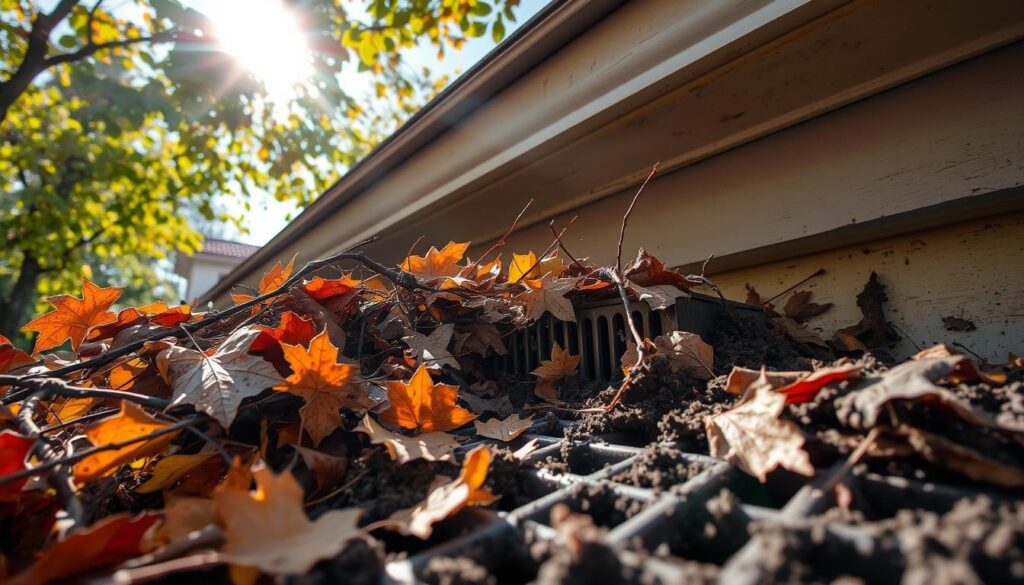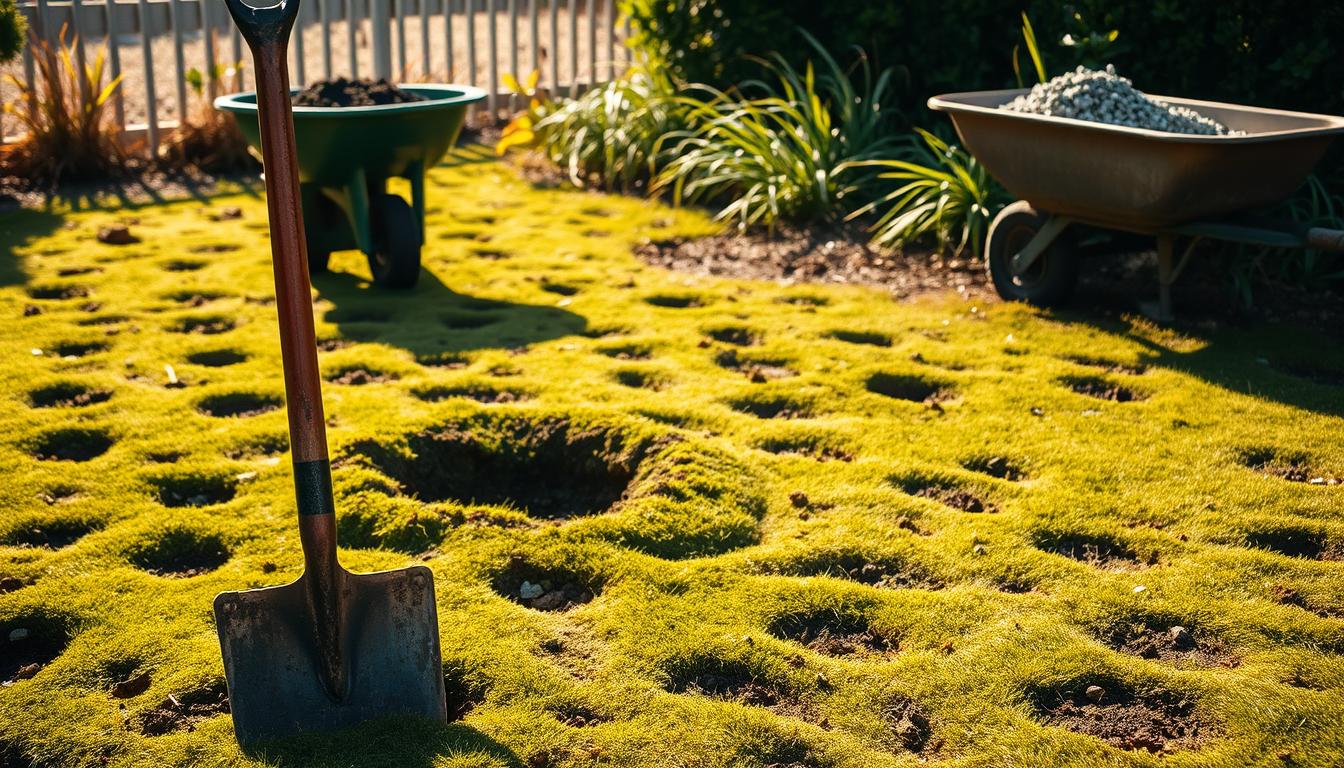As the seasons change, your home needs extra care. Autumn’s beauty also brings fallen leaves and debris. Our fall clean-up services help you prepare your property effectively and keep it looking its best all season long.

Leaves from nearby trees can quickly fill your drainage channels. This buildup can block the entire system. It may lead to leaks and other serious issues around your house.
Regular upkeep is a simple way to protect your investment. It maintains your property’s appearance and prevents expensive future repairs. We recommend clearing out material at least twice a year.
This guide provides practical, step-by-step advice. You will learn about seasonal debris management and safe cleaning methods. We also cover long-term preventative measures for lasting protection.
Our goal is to give you the confidence to handle this important task. Let’s begin by understanding why this seasonal care is so vital for every homeowner.
Why Fall Gutter Clean-Up is Essential
As trees shed their foliage, your home’s gutter system requires immediate attention to prevent costly issues. Blocked gutters and drainage channels during this season create serious risks that demand proactive measures.
Protecting Your Home from Water Damage
When leaves accumulate and create obstructions, water cannot flow properly through your **gutter drainage** system. This leads to overflow that damages your roof and siding materials.
Water may seep into walls or basement areas, causing mold growth and structural weakening. Foundation erosion becomes a real threat when **gutter drainage** fails to direct moisture away from your property.

Benefits of Timely Fall Maintenance
Regular care provides significant protection against expensive repairs. You can identify small leaks or loose sections before they become major problems.
Including fall clean-up as part of your seasonal maintenance ensures debris is cleared before heavy rains and winter storms arrive.
Proper upkeep extends your system’s lifespan and preserves your home’s value. The time invested now prevents far more costly damage later.
Seasonal attention ensures water flows away from your foundation as designed. This proactive approach gives you peace of mind throughout winter weather challenges.
Understanding Seasonal Debris and Gutter Challenges
The composition of material collecting in your drainage channels changes dramatically as nature cycles through its annual rhythms. Each season brings specific types of organic matter that can obstruct water flow.

Types of Debris in Different Seasons
Spring introduces maple buds, oak flowers, and pollen that accumulate quickly. Summer brings seed pods and occasional roof shingle particles from storm activity.
Autumn delivers the heaviest load with leaves, twigs, and acorns overwhelming the system. Winter presents pine needles and potential ice formations that create stubborn blockages.
Weather Impacts on Gutter Performance
Temperature fluctuations cause expansion and contraction that may loosen attachments. Heavy rainfall washes additional particles into the channels while wind deposits extra branches.
Extended dry periods allow moss and algae to establish in standing water. Understanding these patterns helps homeowners plan maintenance when accumulation peaks.
Different tree types near your property significantly affect debris volume throughout the year. This knowledge enables proactive scheduling to prevent system overload.
Safety Measures and Essential Tools for Gutter Cleaning
Proper preparation with the right equipment transforms a hazardous task into a manageable project. We emphasize that personal protection should always come first when working at height. Having the correct tools organized before starting reduces unnecessary trips up and down.
Using Ladders Safely
Choosing the appropriate ladder is crucial for reducing risk. Extension ladders work well for multi-story homes, while A-frame models suit single-story structures better. Always position your equipment on dry, level ground with a spotter present.
Never overreach while working—this shifts your center of gravity dangerously. We recommend using ladder stabilizers that prevent damage to your home’s exterior. Working in clear weather conditions significantly improves safety.
Protective Gear and Equipment Tips
Heavy-duty gloves protect your hands from sharp debris and rusty edges. Safety glasses shield your eyes from falling particles and splashing water. Having all necessary tools ready before ascending minimizes fatigue and exposure.
A gutter scoop provides the most efficient way to remove initial debris. Organizing your approach around specific tools makes the job safer. Proper equipment selection is the best way to ensure a successful project for homeowners.
| Ladder Type | Best Use | Safety Features | Limitations |
| Extension Ladder | Multi-story homes | Adjustable height, stabilizer compatibility | Requires a secure leaning surface |
| A-Frame Ladder | Single-story structures | Self-supporting, stable base | Limited reach height |
| Platform Ladder | Low-height work | Large standing platform | Not for extended reach |
Having the right tools organized before you begin creates a safer working environment. This systematic approach reduces the overall risk associated with elevation work. Proper planning ensures each task proceeds smoothly and efficiently.
Step-by-Step Guide to Cleaning Your Gutters
A systematic approach to maintaining your home’s water management system ensures optimal performance throughout the year. We outline a clear process that homeowners can follow safely and effectively.
Clearing Out Debris and Downspouts
Begin by removing accumulated material from your channels. Use a specialized scoop or gloved hands to extract leaves and compacted organic matter.
Work systematically from corners toward the middle of each section. This prevents pushing debris into downspouts and creating stubborn blockages.
Address downspout clearing before thorough channel maintenance. Flush water from the top while checking flow at the bottom outlet. Use a plumber’s snake for persistent obstructions.
Flushing and Inspecting Your Gutters
After debris removal, employ a garden hose with spray nozzle for final flushing. This washes away remaining particles while revealing potential leaks.
Conduct a comprehensive inspection during this phase. Look for sagging areas, loose attachments, and signs of wear that need attention.
Verify proper drainage by running water through the complete system. Observe flow at downspout outlets to ensure unobstructed movement.
This methodical process delivers reliable results for your property maintenance needs.
Using Alternative Methods for Efficient Gutter Cleaning
Alternative cleaning techniques provide homeowners with options beyond manual debris removal for gutter upkeep. Professional gutter drainage contractors often use these mechanical solutions to save time, reduce physical strain, and achieve excellent results.
Cleaning with a Leaf Blower
Using a leaf blower offers a quick way to clear dry material from your system. Special extension attachments let you work safely from ground level.
This approach works best when leaves are loose and dry. Always wear protective goggles since debris falls downward during this process.
Effective Use of a Power Washer
A power washer with a specialized attachment effectively removes stubborn, wet material. The U-shaped design directs water flow perfectly into the channels.
We recommend moderate pressure settings to avoid damage. After flushing, always inspect for complete debris removal and proper water flow.
Maintaining Gutter Drainage to Prevent Damage
Recognizing the warning signs of blocked downspouts before they escalate is essential maintenance. We focus on helping homeowners identify developing issues in their water management system early.
Proper water flow prevents costly structural damage to your property. Even minor clogs can lead to significant problems if left unaddressed.
Identifying Early Signs of Clogs
Watch for overflowing water, sagging gutters, or water stains on siding—these indicate potential blockages. Test the flow with a garden hose and observe downspout outlets. Slow drainage signals developing clogs. Clear stubborn debris with a plumber’s snake or pressure flush. Regular checks prevent leaks, foundation erosion, and basement flooding, protecting your home year-round.
Understanding Gutter Drainage Systems and Fall Clean-Up Best Practices
Your home’s water management system channels rainfall away from vulnerable areas through gutters, downspouts, elbows, end caps, and ground-level extensions. Autumn’s heavy debris challenges performance, making regular maintenance essential. Roof design and landscaping affect flow, so understanding your system helps target problem areas and prevent property damage before it occurs.
Preventative Maintenance, Repairs, and Gutter Guard Installation
Strategic upgrades and timely repairs work together to create a more resilient water management system for your home. This approach goes beyond basic upkeep to provide lasting protection.
DIY Tips for Minor Repairs and Sealing
Regular inspections during fall cleaning sessions help identify small issues early. You can address minor cracks with quality sealant following the manufacturer’s guidelines.
Reattaching loose hangers and adding support brackets prevents sagging sections. These simple repairs maintain proper water flow and extend system longevity.
Choosing the Right Gutter Guards
Gutter guards offer excellent protection against debris accumulation. Different styles, like mesh screens and foam inserts, suit various needs.
While guards reduce how often you need clean your system, they don’t eliminate maintenance entirely. Good guards can cut cleaning frequency to once a year.
Consider your roof pitch and nearby trees when selecting protection. Some systems work better for DIY installation than others.
Professional gutter services provide comprehensive inspections and repairs. They have the expertise to install gutter guards correctly and identify developing issues.
Conclusion
Taking control of your property’s protection requires understanding the simple maintenance that prevents major issues. Regular attention to your home’s water management system represents one of the most valuable investments you can make.
We recommend clearing debris at least twice per year. Spring and autumn are ideal times for this essential work. Additional sessions may be needed if you have many trees nearby.
This routine care prevents water damage to your roof and fascia. It also protects your foundation from costly erosion. Proper maintenance extends your system’s lifespan significantly.
Approach this job with proper safety gear and the right tools. Whether you choose DIY methods or hire professionals, the time invested is minimal compared to repair costs.
Your home deserves this fundamental protection. With consistent care, your gutters can serve your property reliably for decades.
Keep your home protected this season! Schedule your fall clean-up and gutter maintenance with us today for a worry-free autumn.






